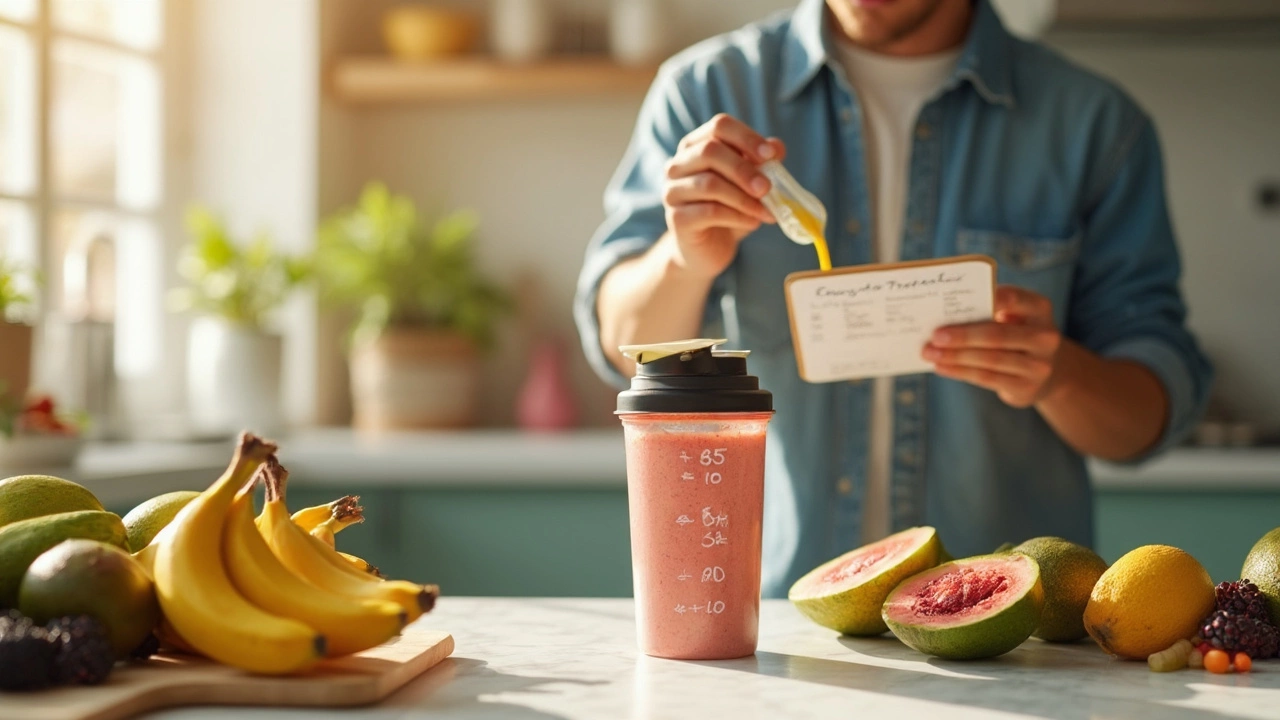
Most people don’t reach for fruit when they think of protein, but it’s not as far-fetched as it sounds. Sure, chicken breast and Greek yogurt still reign supreme, but some fruits sneak in a little protein punch—enough to matter if you add them to your shake game, especially if you’re tired of the same old stuff.
Here’s the real deal: fruit isn’t about to replace your whey powder, but certain kinds do better than others when it comes to protein content. If you know which ones to grab, you can make those post-workout shakes a lot more interesting. Plus, tossing in fruit means you’re getting vitamins, fiber, and natural sweetness—no need for fake flavors.
Here’s the cold truth: fruits just aren’t built to compete with heavy hitters like eggs, chicken, or even beans when it comes to protein. For example, a standard egg has about 6 grams of protein, while a whole chicken breast packs close to 30 grams. Most fruits, on the other hand, barely offer 1–2 grams per serving. It’s a big gap.
The reason is simple—fruits are mostly carbs and water, not protein. That’s their job in nature: give you quick fuel and a hit of vitamins and antioxidants. But if you’re tracking your protein for workouts or muscle repair, you probably won’t hit your goals with fruit alone.
The American Journal of Clinical Nutrition puts it bluntly:
"While fruit can supply small amounts of protein, it should not be relied upon as a primary source for those needing higher daily intakes."Think of fruit as a nice extra, not the main act. You wouldn’t join a tug-of-war with only oranges on your team!
But here’s where fruit actually helps: it takes the edge off super dense, sometimes bland shakes. When you mix fruits high in protein with other protein sources—like nut butters, Greek yogurt, or a scoop of powder—you get a tastier shake plus more fiber, antioxidants, and vitamins. The real win is in combining, not replacing.
If you’re plant-based, fruit on its own won’t handle your protein needs either. You’ll want to team it up with nuts, seeds, or plant-based protein powders for real impact. If you treat fruit as a tasty sidekick to your favorite protein, you’ll have the best of both worlds—nutrition and flavor.
Let’s get real: fruits don’t usually make the cut for protein powerhouses, but a handful stand out if you want a little plant-based boost in your shake. Some choices might surprise you, and they’re worth knowing if you want to get the most out of your fruit game.
Here’s a quick breakdown of protein content per serving (fresh fruit where possible):
| Fruit | Serving Size | Protein (g) |
|---|---|---|
| Guava | 1 cup | 4.2 |
| Avocado | 1 medium | 3 |
| Blackberries | 1 cup | 2.0 |
| Kiwi | 2 small | 2.1 |
| Banana | 1 large | 1.5 |
| Apricots | 4 fruit | 0.9 |
| Raisins | 1/2 cup | 2.7 |
If you’re someone who’s focused on fruits high in protein for your shakes, guava and avocado are seriously underrated. Sprinkle in some blackberries or go for kiwi if you want extra kick and plenty of nutrients. Just don’t expect these to match meat or dairy for protein—they shine when you want to boost taste and nutrition without a lot of fuss.
Fruit isn’t exactly known for being a protein powerhouse, but some options quietly earn their place in the shake world. If you’re chasing those protein numbers, understanding exactly what you get per serving matters. You might be surprised by how these fruits stack up on your daily protein chart—in fact, picking the right ones can actually make a small but real difference in your blend.
Let’s take a look at the actual protein content you get from a typical serving size (that’s about a cup for most fruits):
| Fruit | Protein per 1 Cup (g) | Bonus Nutrients |
|---|---|---|
| Guava | 4.2 | Vitamin C, Fiber |
| Blackberries | 2.0 | Antioxidants, Manganese |
| Oranges | 1.2 | Vitamin C, Calcium |
| Bananas | 1.3 | P otassium, Fiber |
| Avocado | 3.0 | Healthy Fats, Folate |
| Kiwi | 2.1 | Vitamin K, Vitamin E |
| Apricots | 1.0 | Vitamin A, Potassium |
Fruits high in protein tend to max out around 4 grams per cup, with guava taking the top spot by a long shot. Avocados are a close runner-up and bring some healthy fats to the table too, which is awesome for keeping you full. Blackberries and kiwi keep your shake bright and fresh, all while quietly adding to your protein count.
But here’s the kicker: even the best fruits won’t deliver a whole meal’s worth of protein on their own. They’re most helpful as part of a blend—with yogurt, milk, or plant-based protein powder, you’ll hit your goals way faster, and your shake will taste a whole lot better.

It’s easy to up your fruit game in protein shakes without sacrificing taste or protein goals. The trick is picking the options that actually offer some protein—think guava, blackberries, kiwi, apricots, and jackfruit. For example, guava stands out with about 4 grams of protein per cup. Compare that to strawberries, which only have about 1 gram, and you see how smart choices stack up.
Don’t just settle for fruit chunks. Blending these fruits smooth means you get even texture and mix their nutrients evenly with your main *protein shake* base. When I’m throwing together a post-workout shake for me or Nathaniel, I’ll usually blend frozen guava (or blackberries if it’s all I’ve got), a scoop of protein powder, and a splash of almond milk. It fills you up, tastes legit, and squeezes in more protein than you’d expect from fruit.
Try it this way:
Dr. Sarah Ballantyne, health researcher, puts it like this:
"Combining high-protein fruits with other protein-rich foods in smoothies is a smart way to maximize both nutrition and flavor. You get extra fiber and antioxidants, too."
Swapping regular berries or apples for guava or blackberries can actually help your shake pack more of a protein punch. You’re not turning fruit into steak here, but every little boost counts—especially if you’re eating mostly plant-based.
If you want your shake to do more than just taste good, pairing fruits high in protein with other protein-rich foods is the way to go. Fruit alone won’t get you near your daily needs, but it’s a solid sidekick. The trick is to mix fruits that offer a protein boost—like guava, blackberries, or jackfruit—with options that deliver a much bigger hit.
Let’s be real: if you’re aiming for muscle repair or just need to stay fuller longer, classic protein powders like whey, pea protein, or soy are hard to beat. But when you blend them with fruit, you get extra nutrients, better flavor, and that smooth drinkability we’re all after. Here are some combos that never let me down, especially when Nathaniel and I are both hitting the gym hard:
When combining, play with flavors—tangy fruits cut through richer bases like nut butters or yogurt. Always check your protein powder’s label: some brands taste best with fruity blends, others need a bit of extra banana or berries to rescue them from blandness. You’ll notice quickly which combos handle post-workout hunger or make a filling breakfast. Don’t be afraid to improvise!
Adding fruit to your protein shakes is an easy upgrade, but not all fruits are created equal for boosting your protein intake. So, what should you actually do if you want a shake that packs a little more of a protein punch—without losing that fresh, fruity vibe?
First, here are a few really practical tips for getting the most out of fruits high in protein when tossing them into your shake blender:
Here’s a quick look at which common fruits bring the most protein to the table, serving wise:
| Fruit | Protein per cup (g) | Key Benefits |
|---|---|---|
| Guava | 4.2 | Vitamin C overload, fiber |
| Blackberries | 2.0 | Antioxidants, low sugar |
| Jackfruit | 2.8 | Filling texture, good for plant-based eats |
| Kiwi | 2.1 | Packed with potassium |
| Avocado | 3.0 | Heart-healthy fats, super creamy |
Let’s get you out of your plain banana-and-whey rut. Here are three shake recipes that hit the mark for taste, texture and a solid protein boost:
If you want to get more out of your shakes, don’t just settle for extra protein—give your tastebuds something fun with smart fruit picks. Now you know exactly which fruits to grab, what to mix, and how to keep those routines exciting and nutritious, even if you follow a plant-based plan at home like I do with Nathaniel.